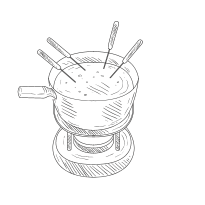Are you a fan of indulging in the creamy, gooey goodness of fondue? If so, you’re in for a treat! In this article, we’ll be exploring the classic cheese pairings that are perfect for creating the ultimate fondue experience. Get ready to dip into a world of tantalizing flavors as we share the secrets behind creating the perfect blend of cheeses that will elevate your fondue to new heights. So grab your favorite dipping items and prepare to embark on a delicious culinary adventure!
Gruyère
Description
Gruyère cheese is a popular Swiss cheese known for its distinct nutty and savory flavor. It has a pale yellow color and a firm, yet creamy texture. The cheese is made from cow’s milk and has small, scattered holes throughout. Gruyère has a rich and complex flavor profile, with notes of caramel and fruitiness, which intensify as the cheese ages.
Origin and History
Gruyère cheese takes its name from the Swiss town of Gruyères, where it originated in the 12th century. It is believed to have been produced by monks in the region. The traditional method of making Gruyère involves using raw milk and a long aging process, which contributes to its unique flavor and texture. Over the years, Gruyère cheese has become a revered Swiss cheese variety, beloved for its versatility and exceptional taste.
Ideal Pairings
Gruyère cheese is incredibly versatile and pairs well with a variety of flavors. Its nutty and savory taste complements both sweet and savory ingredients. One classic pairing for Gruyère is with dried fruits such as figs or apricots, as the sweetness of the fruits balances out the savory notes of the cheese. Gruyère also pairs well with cured meats like prosciutto or salami, which provide a salty contrast to the richness of the cheese. For a more indulgent combination, try melting Gruyère over a slice of crusty bread and topping it with caramelized onions. The combination of the sweet, savory, and creamy flavors is simply irresistible.
Emmental
Description
Emmental cheese, also known as Swiss cheese, is easily recognized by its iconic holey appearance. It has a pale yellow color and a firm yet supple texture. Emmental has a mild, slightly sweet flavor with a hint of nuttiness. The cheese is made from cow’s milk and has large, irregular holes throughout, known as “eyes.”
Origin and History
Emmental cheese originates from the Emme River Valley in Switzerland, where it has been produced for centuries. The cheese gained popularity during the Middle Ages and was highly prized for its excellent quality. Traditionally, Emmental is made using raw cow’s milk and has a long aging period of about three to four months. This aging process allows the cheese to develop its distinct flavor and characteristic holes.
Ideal Pairings
Emmental cheese’s mild and slightly sweet taste pairs well with a variety of ingredients. It is a popular choice for sandwiches and melts due to its melting properties. One classic pairing for Emmental is with apples or pears, as the fruity sweetness complements the cheese’s nutty flavor. Emmental also works well with smoked meats like ham or turkey, adding a creamy and slightly tangy element to the overall flavor. For a more traditional Swiss experience, enjoy Emmental with a slice of crusty bread, some cornichons, and a glass of white wine.

Fontina
Description
Fontina cheese is a semi-soft Italian cheese known for its creamy texture and delicate flavor. It has a pale yellow color and a smooth, slightly elastic consistency. Fontina has a mild and buttery taste with a subtle hint of earthiness. The cheese is made from cow’s milk and is aged for about three months, allowing it to develop its distinctive flavors.
Origin and History
Fontina cheese originated in the Aosta Valley in northwest Italy, where it has been produced for centuries. It is believed that shepherds in the region started making Fontina as a way to preserve surplus milk. The cheese gained popularity and eventually received a Protected Designation of Origin (PDO) status, ensuring that only cheeses produced in the Aosta Valley can bear the Fontina name. Today, Fontina is a beloved Italian cheese enjoyed both in its home country and around the world.
Ideal Pairings
Fontina cheese’s creamy and buttery flavor pairs well with a variety of ingredients. It is a popular choice for melting due to its smooth and melty texture. One classic pairing for Fontina is with mushrooms or roasted vegetables, as the earthiness of the ingredients complements the cheese’s rich flavors. Fontina also works well in pasta dishes like risotto or macaroni and cheese, adding a velvety and savory element to the dish. For a simple yet delicious combination, enjoy Fontina on a slice of crusty bread, alongside some fresh grapes and a glass of red wine.
Appenzeller
Description
Appenzeller cheese is a traditional Swiss cheese known for its bold and robust flavor. It has a golden yellow color and a firm, slightly grainy texture. Appenzeller has a complex flavor profile, with notes of fruitiness, nuttiness, and a hint of spiciness. The cheese is made from raw cow’s milk and is aged for a minimum of three months, allowing it to develop its distinctive taste.
Origin and History
Appenzeller cheese hails from the Appenzell region of Switzerland, where it has been produced for over 700 years. The cheese is closely associated with Swiss traditions and craftsmanship. Appenzeller cheese making involves a unique combination of traditional methods and special herbal brines, which give the cheese its distinct flavors. Each wheel of Appenzeller undergoes regular brine washings, which contribute to the cheese’s robust taste and unparalleled quality.
Ideal Pairings
Appenzeller cheese’s bold and complex flavor makes it a versatile choice for pairings. It pairs well with ingredients that can match its intensity and bring out its unique character. One classic pairing for Appenzeller is with cured meats like pepperoni or bresaola, as the spiciness of the meat complements the cheese’s complex flavors. Appenzeller also pairs well with pickled vegetables or mustard, adding a tangy and zesty element to the overall taste. For a traditional Swiss experience, enjoy Appenzeller cheese with some rye bread, accompanied by a glass of beer or a robust red wine.

Comté
Description
Comté cheese is a popular French cheese known for its nutty and sweet flavor. It has a pale yellow color and a firm yet supple texture. Comté has a rich and complex taste, with notes of caramel, fruitiness, and a hint of hazelnut. The cheese is made from raw cow’s milk and is aged for at least four months, but can be aged for up to several years.
Origin and History
Comté cheese dates back to the time of Charlemagne in the 8th century. It originates from the Franche-Comté region in eastern France, where it has been produced for centuries. The cheese is deeply rooted in the region’s traditions and is made using time-honored methods. Comté cheese-making involves a strict set of regulations, ensuring that only cheeses produced using traditional methods and local milk can bear the Comté name.
Ideal Pairings
Comté cheese’s nutty and sweet flavor pairs well with a variety of ingredients. It is a popular choice for cheese boards and charcuterie platters due to its exceptional taste. One classic pairing for Comté is with fresh fruits like grapes or apples, as the sweetness of the fruits complements the cheese’s nutty notes. Comté also works well with crusty bread or crackers, allowing the cheese to shine on its own. For a more indulgent combination, melt Comté onto a slice of crusty bread, top it with a dollop of honey, and sprinkle some chopped nuts for added texture and flavor.
Raclette
Description
Raclette cheese is a Swiss cheese renowned for its creamy and indulgent taste. It has a pale yellow color and a semi-soft, pliable texture. Raclette has a rich and buttery flavor with a slight tanginess. The cheese is made from cow’s milk and aged for about three months, allowing it to develop its distinctive taste.
Origin and History
Raclette cheese has its origins in the Swiss and French Alps, where it has been produced for centuries. The name “raclette” comes from the French word “racler,” which means “to scrape.” Traditionally, Raclette cheese was melted over a fire and scraped onto potatoes, vegetables, or bread. This traditional method of serving Raclette is still popular today, both in Switzerland and around the world.
Ideal Pairings
Raclette cheese is a versatile choice for pairings, especially when it comes to its traditional serving method. It pairs exceptionally well with ingredients that can withstand its creamy texture and enhance its indulgent flavor. One classic pairing for Raclette is with boiled potatoes, pickles, and onions, just like it is traditionally served. The combination of the rich and gooey cheese with the tangy and crisp pickles creates a delightful contrast of flavors and textures. Raclette also pairs well with cured meats, allowing the saltiness of the meat to balance out the creaminess of the cheese. For a festive twist, melt Raclette over bread and top it with caramelized onions or sautéed mushrooms for a mouthwatering treat.
Taleggio
Description
Taleggio cheese is a soft Italian cheese known for its pungent aroma and creamy texture. It has a pale yellow color and a thin, edible rind. Taleggio has a tangy and yeasty flavor, with hints of fruitiness and earthiness. The cheese is made from cow’s milk and is aged for about six to ten weeks, allowing it to develop its unique taste and character.
Origin and History
Taleggio cheese originates from the Lombardy region in northern Italy, specifically the Val Taleggio valley. It has been produced since the 9th century and is deeply rooted in Italian culinary traditions. Taleggio cheese-making involves a specific set of techniques, including hand-turning the cheese and washing it with salted water, which contribute to its distinct flavors and aromatic qualities. Today, Taleggio is enjoyed both in its home country and internationally.
Ideal Pairings
Taleggio cheese’s pungent and creamy flavor pairs well with a variety of ingredients. It is a popular choice for cheese boards and sandwiches due to its unique taste. One classic pairing for Taleggio is with sweet fruits like pears or grapes, as the natural sweetness of the fruits counterbalances the cheese’s tanginess. Taleggio also works well with crusty bread or crackers, allowing the cheese to be the star of the show. For a delightful combination, melt Taleggio onto a slice of crusty bread, top it with a drizzle of honey, and sprinkle some chopped walnuts for added crunch and flavor.
Camembert
Description
Camembert cheese is a soft and creamy French cheese known for its rich and indulgent taste. It has a white bloomy rind and a pale yellow interior. Camembert has a buttery and slightly tangy flavor with earthy undertones. The cheese is made from cow’s milk and is aged for about three weeks, allowing it to develop its distinct taste and texture.
Origin and History
Camembert cheese originated from the Normandy region in northwestern France, where it has been produced since the late 18th century. The cheese takes its name from the village of Camembert, where it was first made by Marie Harel, a local farmer. Camembert’s popularity grew rapidly, and it soon became one of the most famous French cheeses. Today, Camembert is enjoyed worldwide and is considered an emblem of French culinary expertise.
Ideal Pairings
Camembert cheese’s creamy and indulgent flavor pairs well with a variety of ingredients. It is a popular choice for cheese plates and baked dishes due to its melting properties. One classic pairing for Camembert is with crusty bread or crackers, as the simplicity of the bread allows the cheese to shine. Camembert also pairs well with tart fruits like apples or grapes, as the acidity of the fruits balances out the cheese’s richness. For a delicious combination, bake Camembert in its wooden box with some garlic and herbs, and serve it alongside freshly baked bread for a warm and comforting treat.
Cheddar
Description
Cheddar cheese is a popular and widely recognized cheese known for its sharp and tangy flavor. It has a pale yellow or orange color, depending on the addition of annatto, and a firm, crumbly texture. Cheddar has a rich and robust taste with a hint of nuttiness. The cheese is made from cow’s milk and is aged for varying periods, ranging from a few months to several years.
Origin and History
Cheddar cheese originated in the English village of Cheddar in Somerset, where it has been produced since at least the 12th century. The cheese-making technique of Cheddar involves the process of cheddaring, which gives the cheese its name. Traditionally, the curds are stacked and turned, creating a unique texture and flavor. Cheddar gained popularity and soon became one of the most widely produced and consumed cheeses in the world.
Ideal Pairings
Cheddar cheese’s sharp and tangy flavor pairs well with a variety of ingredients. It is a versatile cheese that can be enjoyed in numerous ways. One classic pairing for Cheddar is with apples or pears, as the sweetness of the fruits complements the cheese’s sharpness. Cheddar also works well in sandwiches and burgers, adding a robust and savory element to the overall taste. For a comforting combination, melt Cheddar over a bowl of hot tomato soup or macaroni and cheese for a cozy and satisfying meal.
Parmesan
Description
Parmesan cheese, also known as Parmigiano-Reggiano, is a hard Italian cheese renowned for its strong and nutty flavor. It has a pale yellow color and a granular texture, with small, crunchy crystals throughout. Parmesan has a complex and savory taste, with notes of fruitiness and a hint of saltiness. The cheese is made from cow’s milk and is aged for a minimum of 12 months, but can be aged for up to 36 months or more.
Origin and History
Parmesan cheese originates from the Emilia-Romagna region in northern Italy, specifically the provinces of Parma, Reggio Emilia, and parts of Bologna and Mantua. The cheese has been produced since the Middle Ages and is deeply rooted in Italian culinary traditions. Parmesan cheese-making involves a strict set of regulations and quality control measures, ensuring that only cheeses produced using traditional methods and ingredients can bear the Parmigiano-Reggiano name.
Ideal Pairings
Parmesan cheese’s strong and nutty flavor pairs well with a variety of ingredients. It is a versatile cheese that can enhance the flavor of numerous dishes. One classic pairing for Parmesan is with balsamic vinegar or aged balsamic glaze, as the acidity of the vinegar complements the cheese’s complex flavors. Parmesan also pairs well with cured meats like prosciutto or salami, adding a salty and savory element to the overall taste. For a simple yet delicious combination, grate some Parmesan over a bowl of freshly cooked pasta and drizzle it with extra virgin olive oil for a delightful Italian dish.
In conclusion, these classic cheeses – Gruyère, Emmental, Fontina, Appenzeller, Comté, Raclette, Taleggio, Camembert, Cheddar, and Parmesan – offer a wide range of flavors and textures to suit every taste. Whether you’re looking for a creamy and indulgent cheese or a sharp and tangy option, these cheeses are sure to satisfy. Pair them with your favorite ingredients, from crusty bread and fresh fruits to cured meats and pickled vegetables, and create delightful combinations that will tantalize your taste buds. So go ahead, explore the world of classic cheeses, and indulge in the rich and diverse flavors that they have to offer. Happy cheese tasting!

